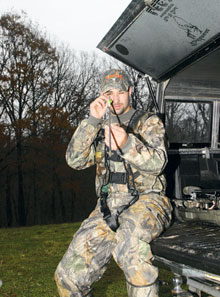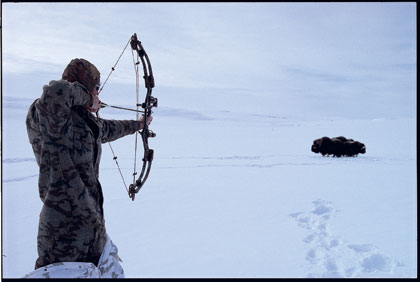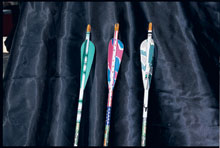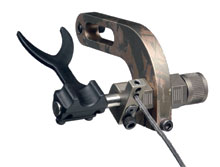October 28, 2010
By Patrick Meitin
The magic of perfect arrow performance.
By Patrick Meitin
 |
I've been fascinated by the flight of the arrow since childhood. On more than one occasion as a youngster I found myself in hot water after hacking off a piece of family landscaping for yet another of my hand-hewn "selfbows." While other kids yawned during archery sessions down at the YMCA, I had to be dragged away when the boring swimming pool or arts and crafts followed on the roster. When 10, I mowed maybe 37 lawns to buy a Fred Bear fiberglass recurve with 30-pound draw, a boxed kit including cedar arrows, arm guard, glove and hip quiver. I shot that bow until my fingers blistered. Shortly afterwards neighborhood rabbits remained in a constant state of terror; nearby creek carp gaining newfound wariness. I acquired a 45-pound laminated recurve two summers later and killed my first deer with it by that fall. Since then I've bowhunted with any kind of archery gear conceivable, from the most primitive to tricked-out, high-tech compounds, in locations as wide flung as Alaska and Africa. The flight of the arrow still haunts me.
There's nothing so beautiful to my eye as that moment of arching suspension, a clean arrow spinning toward the intended target. I still can't shake the notion, no matter how modern my equipment becomes, that there's magic involved, directing that arrow into a wee little spot way out yonder. The marvels of modern technology make this no less wondrous, watching slow-motion footage of a released arrow, seeing all those wildly oscillating bow parts, arrows coming off the string like wet noodles. It's always fascinated me that we hit anything at all. Maurice Thompson, one of the very first to write about archery, called it the Witchery Of Archery. There's magic in the flight of the arrow, but you can be the wizard who controls its outcome.
Advertisement
Form And Function
Repeatability, consistency, is what archery perfection is all about. This starts with choosing gear that fits your particular stature, makes it comfortable and natural to shoot well. Tuning follows, matching arrows to draw weight and length, aligning every component so that it works together smoothly to launch arrows true. Shooting form factors heavily, assuring that your arrow is set into motion in the same manner each and every shot. I'll not bore you with a droll repetition of shooting form and tuning details that have been covered at great length already. There's plenty of information out there, plus qualified archery pro-shop professionals are eager to help. Still, I feel inclined to share a few tidbits.
Trained pro-shop employees assure that you purchase a bow with correct draw length most importantly, but also one with reasonable draw weight. This applies no matter your equipment preferences. If you can't comfortably point your bow directly at the target and pull it straight back smoothly, you're shooting too much draw weight. Back it off and you'll shoot better. You should be able to remain at full draw for no less than 10 seconds without becoming shaky, no matter your bow type. If not, back it off.
Advertisement
 There are times even in severe weather conditions when feathers are simply the better choice. In the sub-zero temperatures of the author's recent muskoxen hunt, feathers made the only real choice. When it's this cold--negative 25 degrees--vanes can turn stiff and become highly unforgiving. |
Shooting a draw length that's too long is a mistake made by even experienced hands. In days past, extending yourself maximized power stroke and energy potential. Today's bows are simply more efficient, making this thinking outdated. You can now sacrifice an inch or two in draw length and still produce more Kinetic energy than you did in the past. Bend your elbow slightly, turning it down to help lock it in place, choosing an anchoring point on a more reliable forward point on your face. Pull your shoulder blades together, using your strong back muscles instead of your arms to steady the shot. A shorter draw length also helps eliminate interference from hat brims and such, and string slap on bulky cold-weather clothing that can ruin important shots at game.
Consistent shooting form is then everything. Your anchor point must be exactly the same every time, how you hold your head, your grip, body angle, eye squint, which pocket you put your wallet in. I'm getting carried away, of course, but you get the picture. Practice a smooth release, even if you must stand five feet before the target and shoot blindfolded, concentrating on nothing but a smooth and even slip of the string or surprise trigger squeeze. Again, if you don't understand what I'm talking about, ask for help from an experienced shooting coach.
The single-most important piece of advice for shooters of all skill levels, in my opinion, is remembering to follow through. Put simply; continue aiming through the shot until your arrow strikes the target. Continue boring a hole through that spot you've chosen (Always Pick A Spot!), attempting to hold your pin on target after release. In more Zen-like terms, I like to believe I can direct the path of my arrow telepathically, concentrating on that arrow from launch through impact in an attempt to direct its destination. A military friend tells me he looks at his arrows as wire-guided missiles, a system requiring constant aiming from launch to impact. When it's working, I call it falling into "The Zone." It requires concerted concentration, an exhausting exercise when maintained for long periods such as during 3-D tournaments.
Super Tuning
There's tuning, and there is tuning. To set your bow up like a pro, first invest in a bow vice. Models like those from Sure-Loc or R.S. Archery Products allow you to work hands-free. Secure your bow in the clamp, attaching R.S.'s Snap-On String Level to the serving to level the bow (top cam up). Install your rest, adjusting it to the recommended height, be it a standard or drop-away model. Snap an arrow onto the string and use R.S.'s Arrow Level to find 90-degree plumb, installing your nocking point or string loop accordingly (remember, nocking points need to be about 1/8-inch high for fingers, dead even for release).
 LimbSaver's Stealth Fletch from Sims are made of special Navcom II vibration-dampening material to help settle arrows faster after release, as well as assure quiet flight. They are designed to tighten groups and increase accuracy. |
Return the arrow to the string and step about three feet behind the bow. Sight along the string (not buss cables) and cam flats, so that you see only the thinnest edges of the cams or wheels. Adjust rest center shot so t
he string sights down the shaft center, nock to tip. This is precisely double checked with Easy-Eye's new and more affordable EZE-Center LTA, a laser tool that mounts onto the riser with knurled knobs, adjusted to sight along the string, then to check alignment along the entire span of a nocked arrow. The smallest deviation is quickly revealed with laser-straight precision.
This laser can also be used to detect accuracy-eroding cam lean. Lay your bow on a flat surface and sight the laser along the flat of one cam, across to the opposite. The laser should shoot across both cam flats without interference. If a laser mark shows on one part of a cam, without touching the rest of the cam flat, it should be adjusted for lean. This is why modern bows hold split harness buss cable systems. Use a bow press to relax tension, twisting a single harness yolk to pull the cam straight. This can involve some trial and error, but assures bows shoot their most accurate; while also assuring longer overall bow life.
 Today's drop-away arrow rests, such as this one from Cobra, allow archers to use more aggressive helical fletching to help stabilize fixed-blade broadheads and increase hunting accuracy. Combined with today's shorter, faster compounds they add forgiveness. |
Now stand 20 yards before a target and shoot at a small mark. Hang a chalk line from one of those arrows and create a vertical line. Walk back to 30 yards and shoot another group, assuring arrows are flying clean. Arrows should group on the line. Consistent hits to the right mean the rest should be moved left, and vice versa (for right-hand shooters). Move back another 10 yards and try again, doing this until you have reached your maximum effective range. The aim is to achieve consistent groups on the center line at all ranges.
Battling Ends
Fletchings have one purpose--stabilizing arrows. They do this on two fronts; creating rear-arrow drag to keep the point out front where it belongs, and introducing spin to help arrows better stay their course.
Feathers are light and create more stabilizing drag. They also prove more forgiving around arrow rests, making for easier tuning. They are also noisy, less durable, and ineffective when wet. Vanes are extremely durable, impervious to whether, and more aerodynamic at longer ranges. Vanes are unforgiving around arrow rests, and heavier than feathers. Feathers give you faster initial launch speeds, due directly to lighter weight, yet increased drag means more aerodynamic vanes overtake them at about 50 yards, all other factors remaining equal. Put simply, feathers require less tuning, but don't last as long. Vanes require additional tuning skills, but last much longer.
 A poorly executed shot at 35 yards forced the author to administer a 78-yard finisher on this fine pronghorn, stalked on the ground in western New Mexico. Accuracy at such range was once unheard of, but with better equipment and refined tuning skills the lines of "long range" have blurred. |
New vane designs have gained newfound stability with engineering that increases spin rates. Like a rifle bullet, or gyroscope, the faster an object spins the more stable it becomes. New Archery Products' Quik-Spin vanes promise to increase arrow rotation by up to 300-percent over conventional vanes. They include patented micro grooves on one side to channel air over the vane for flatter trajectory, and rear spoiler lips to increase arrow spin for greater stability. They also stabilize arrows in less than half the distance of both vanes and feathers. They're available in 1.5-, 2.25-, new 3.125-, and four-inch lengths.
LimbSaver vanes also offer increased arrow stabilization. "Next generation" Navcom II material helps shorten settling time and vibrations in flight. This makes for a more accurate arrow and a stealth edge. Look for them in a four-inch length. Another departure worth mentioning is Bohning Archery's Blazer Vanes. This two-inch, five-grain (half the weight of standard four-inch vanes) wonder combines super-strong material, higher profile, and a precise leading edge angle to maintain control of even large fixed-blade broadheads. Lighter weight gives you greater speed, without sacrificing accuracy.
Remember, too, that today's fall-away rests allow archers to add more fletching helical or spin, without worrying about rest clearance. It seems some still haven't adjusted their fletching jigs since the days of shoot-through rests, still wielding the straight-fletch attitudes of yesterday. Drop-aways allow you to adjust your fletching jig for ultra-aggressive helical and maximum spin. If you're shooting a release and not utilizing a drop-away, you're missing out on a world of added accuracy, especially with broadheads.
Fletching type goes hand-in-hand with broadhead style. Large, one-piece-welded heads once so in vogue required big five-inch feathers, habits that carried over into the wide-cutting, 125-grain replaceable-blade heads and vanes that followed. Four-inch fletchings soon took over as standard when slimmer carbon came onto the scene, five-inch more difficult to maintain both complete adhesion contact and aggressive helical, and as 100-grain heads gained more favor. At the same time fixed-blade heads grew more aerodynamic. The nearly-nonexistent blade surfaces of modern mechanical designs soon encouraged many archers to choose fletchings as small as two to three inches without ill effects, while also picking up a speed advantage due to less drag.
When situations demand it--on bigger, tougher game--or if you simply prefer a wide-cutting fixed-blade head, fletchings up to five inches still make good sense. At average bowhunting ranges you're loosing very little, while drop-away rests simply make them retroactively more practical. The new mini head craze, heads with 7⁄8- to one-inch cutting diameters and abbreviated blade surfaces, makes four-inch fletchings perfect for fixed-blade heads, while some will try to push the limits with shorter lengths, especially feathers that add a bit more stabilization. Some of the special fletchings I've mentioned, as well as feathers, stabilize these aerodynamic heads especially well in their shortest offerings. Mechanical designs allow the very smallest fletchings, essentially anything that will also steer a field point. That said, bowhunting scenarios involve many more variables than target archery. Play it safe, even with mechanicals, by choosing the largest practical fletching for the job at hand--instead of the smallest you can get away with.
There are many factors affecting arrow flight and resulting accuracy. Properly-fitted and matched equipment, fine tuning, attention to detail in areas of shooting form, even the fletching and broadhead combination you choose, all make the difference between consistent groups or scattergun frustration. Today's high performance equipment has made every one of these factors more critical. Shooting faster, shorter bows well means even more attention to detail in every facet of your shooting. But it's still all about the magic of that brief moment in time--getting briefer every year!--when your arrow hurls through space, spinning and hanging
in momentary suspension, cutting cleanly to a small point way over yonder, when we hold our breath and watch the flight of the arrow.
